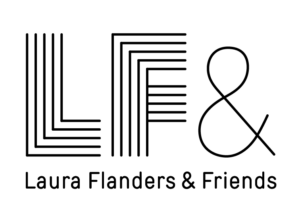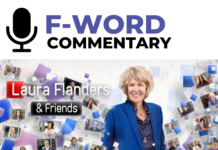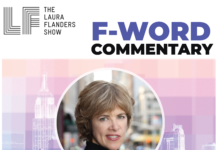In the midst of yet another year of climate catastrophe, the U.S. Senate is negotiating a $3.5 trillion infrastructure package. President Biden, among others, is calling for extensive investment to lower emissions and combat the effects of climate change. But what sort of investment? In this episode, Laura interviews environmental lawyer Colette Pichon Battle in Louisiana about the strategies organizers there have developed since Hurricane Katrina for equitable green development and climate justice. Then, she speaks in depth with MacArthur “Genius” award-winning landscape architect Kate Orff about her innovative work on oyster reefs, living breakwaters and regenerative infrastructure. Recently profiled in the New Yorker Magazine, Orff insists that ecology is the infrastructure of the future. Her work restores and harnesses—rather than resists—natural systems to ensure the livability of our rapidly changing world. Plus, Laura shares some thoughts about community vs. concrete.
“At the very moment when we have this opportunity in front of us, to invest in a climate adaptation roadmap for the nation, we have to act!” — Kate Orff, SCAPE landscape
Guests
- Kate Orff, Landscape Architect, Founding Principal, SCAPE
- Colette Pichon Battle, Executive Director, Gulf Coast Center for Law & Policy
To listen to the uncut interviews, and to get episode notes for this episode and more, become a Patreon partner here.
Prefer to Listen
Transcript
THE LAURA FLANDERS SHOW
ECOLOGY: THE INFRASTRUCTURE OF THE FUTURE?
LAURA FLANDERS: When Hurricane Ida hit the Gulf Coast this August exactly 16 years after Hurricane Katrina, all eyes were on New Orleans’ new levee system. The levees that failed so disastrously back then have been invested in and rebuilt in the years since. They didn’t fail this time. And you could almost hear a collective sigh of relief, but MacArthur genius award-winning landscape designer, Kate Orff believes that gray infrastructure like levees, and flood gates, and sea walls can only take us so far. The infrastructure we need, she says, isn’t gray, but green. With climate change now a fact of life, we can’t indefinitely hold back rising tides, for example, but we do have the capacity to go forward, not fighting nature, but designing creatively, softly with it. Recently profiled in The New Yorker Magazine, Kate Orff is gonna tell us all about the work she’s doing with oysters, and reeds, and willows, and wetlands, and at-risk communities, and people. But first, for a reality check of how things are playing out on the ground after Ida, we’re gonna go to Colette Pichon Battle in Louisiana. She is the founder and executive director of the Gulf Coast Center for Law and Policy. Colette, welcome back to the show. Our hearts are with you. Where are you right now? What’s top of your mind as we have this conversation?
COLETTE PICHON BATTLE: I’m calling in today from North Texas in the Dallas Fort Worth area. We’re still evacuated from my home at St. Tammany Parish, which is in that southeast corner just before the Mississippi border. Top of mind right now is really just getting back to our home. We’re hoping to leave early tomorrow morning. We’ve got information that our power is back on. We did stay through the storm and we watched the water rise. We watched the wind. It was a very intense, and scary at times, moment but we were lucky that the flooding that could have been did not happen to us on the North shore as we call it. The problem was we were out of power, and on day four at about 113 on the heat index, waiting it out wasn’t what we could do anymore. So I came here to Texas where quite ironically, my mom evacuated from Katrina 16 years ago and now lives. And here’s where we are today.
LAURA FLANDERS: So since Katrina, there’s been all this talk about investing in the levee system and the tidal control systems that now kind of ring parts of the Gulf Coast. How has the investment been on the community side when it comes to infrastructure?
COLETTE PICHON BATTLE: The sea walls that have been built did mitigate flooding, but it’s also important to acknowledge that the mitigation of flooding in places like Houma, lower Terrebonne, lower Lafourche parishes and places like Plaquemines Parish that are outside the levee system meant that some people got as much as eight feet of water into their homes. Quite incorrectly, Hurricane Katrina is always sort of linked back to New Orleans as though the eye of the storm went over that city. But it didn’t, it went just east of the city. It’s important to acknowledge that hurricane Ida went just west of New Orleans. So both times, the eye of the storm missing that city, the levees were not tested. And we shouldn’t think that they were, I think the narrative is wrong. Gray infrastructure is not what’s gonna save us from a global climate crisis. And what we’re seeing now is just the beginning. And if just the beginning we’re at eight feet of water in people’s houses, and not really tested around big cities like New Orleans, I think we’ve got to stay alert and stay vigilant.
LAURA FLANDERS: Now, you always make the point when we talk that a healthy ecology is not just about the environment. It’s also about law, and policy, and community, and people. Talk a bit about what you mean when you say, you know, a healthy ecology requires justice.
COLETTE PICHON BATTLE: The truth of the matter is right now in south Louisiana and some parts of Mississippi, and even some parts of Texas, the government, corporations, other people are not around. Neighbors are having to help each other. What we need right now are laws that protect the people, not the corporations that are actually accelerating this climate crisis, that infrastructure bill, that reconciliation package, billions of dollars in for fossil fuels. We need our federal government to make laws and policies that invest in our people and our frontlines. We have no more time to waste.
LAURA FLANDERS: Now, President Biden came out strongly talking about the intergovernmental panel on climate change report saying, “Indeed, yes, we’re at code red for the human race, with respect to climate change.”
PRESIDENT BIDEN: And so, folks, we gotta listen to the scientists, and the economists, and the national security experts. They all tell us this is code red.
LAURA FLANDERS: He gathered electric car manufacturers, unions, and also talked about the danger of sort of green gentrification, or at least it came up in the conversation. Talk about what you heard there that was encouraging and what gave you pause.
COLETTE PICHON BATTLE: I’m encouraged that we finally have a president who can say climate change is real and it has real consequences. I’m less encouraged, I’m worried that we’re giving all of these words, but doing actions that are to the contrary. We don’t yet have an administration that’s putting the people before these fossil fuel companies make their profit. We don’t yet have decision makers. I mean, we’re watching some of these senators and representatives halt and take out climate portions so that the bills that are in front of Congress right now can pass with bipartisan support. What I’m seeing is an investment into ensuring that the fossil fuel company doesn’t lose its profits, or that we make sure that we stay friends with the very root causes of the problem. But we’ve gotta change. This is not about transition, this is about transformation. It’s time right now to consider what does it look like to provide food, and housing, and transportation, and education for everyone. And let the profit margins be made off of luxury items and luxury things. But the basic elements of human existence and human dignity should not be up for profits, certainly not in the midst of a tragedy. And this green building and the greenwashing, when it’s rooted in capitalism, it cannot work. When it’s rooted in collective community power, it can save us.
LAURA FLANDERS: There have been on the other side of the equation, extraordinary mutual aid networks that have built up over the months of COVID. Many of them were there after Katrina, may have endured and revived themselves to address the pandemic. How are people actually meeting needs that are not being met by corporations or governments right now? And how can viewers and listeners, if they wanna find out more, do that?
COLETTE PICHON BATTLE: It’s the community, it’s the community, it’s the community. I mean, I think, pre-Katrina, Louisiana had some of the highest numbers of residents that never left the state. And while that sounds odd to many people who just pick on the map where they wanna live and pick a neighborhood that they wanna live in, for south Louisiana, for a lot of folks, the place where you live is the place where your mother lived, your grandmother lived, and so on, and so on. The deep networks that exist in community are quite valuable. You can’t put a dollar amount on culture. You can’t put a dollar amount on trust, and this is what communities have intact. We’ve gotta invest in the frontlines. You’ve gotta invest in the communities. We’ve gotta invest in the people who know, trust, and love the people around them. I’ve got a neighbor, people are often confused how we’re friends, they have very different political views than I do. My neighbor has been watching my house every day. I get daily updates on what’s going on. I asked them if they need me to bring gas back, this is how this is gonna work. And it’s gonna require us to bring our nation together with something not rooted in fear, but rooted in love and abundance. We can do it if we try. We’ve gotta value everyone equally. We’ve gotta get rid of this economic system that is about extraction and not sustainability. And maybe, just maybe if we act quickly as a nation, this won’t be a code red for us, but I fear we’re getting very close to that line.
LAURA FLANDERS: From the Gulf Coast, we go now to the New York region where the remnants of Hurricane Ida did damage too. Their landscape architect, Kate Orff was watching the hurricane approach with a sense of deja vu. Kate, you and your firm, SCAPE, work on design projects in many parts of the United States, including in Louisiana and New York. When you saw Hurricane Ida this year barreling towards both those places and others too, what went through your mind?
KATE ORFF: I had a little bit of a flashback to the evening that Superstorm Sandy hit our region. You can’t imagine watching the meteorology and it looks literally like a comet headed straight for your region. And in the case of Superstorm Sandy, it went directly up the New York side. And the case of Ida, it came through Louisiana and up and over the sort of Central United States. Just the tale of these two storms, if you will, just describes how the risk that we face is truly diverse. There’s not one kind of climate risk in our built environment. There’s not just sea level rise to contend with or extreme heat. We are looking, like in the case of Ida, at a rain storm that dropped just incredible amounts of rain on our built environment, which we’ve largely paved over. So, we had a very, very different set of challenges in the region here after Ida, flash flooding, some very tragic deaths in my borough of Queens, people living in basement apartments actually that were located, or that are located in a former lake. So, we’ve covered up much of our nature-based infrastructure and we filled it in, and now we are living with the risks that we have built.
LAURA FLANDERS: So you’ve just put your finger on it, I mean, a variety of challenges changing all the time, unpredictable, complex systems intersecting, not just with our habitat, but our habits of development, and housing, and where we put people and who. Talk for a minute about how that relates to the point that I hear coming across from you so strongly that one solution, particularly, a built concrete type solution won’t be all we need to deal with climate change. And instead we need this kind of collaborative approach where we work with nature for something that you called regenerative design.
KATE ORFF: Absolutely. I feel like maybe, 1927 was a seminal time for America. We had major floods in the Mississippi River area, and there was a big movement to build levees and pull and gray infrastructure up and down the Mississippi River system. And that kind of set into motion this approach, which was like build a wall and then if it floods, just build it higher, spend more money, and more, and more money to kind of try to reduce risk by securing this through edges, through hard infrastructure, kind of like try to lock natural systems in place. But, of course, that is not the way that natural systems respond. And that obviously, is wholly insufficient for a climate changed environment where we’re experiencing more rain, flashier for rain, like more intense rain in many regions where we are facing more extreme heat where sea levels are rising. And so, the old rules, frankly, do not apply.
LAURA FLANDERS: Am I hearing you right, that it would be a mistake for people to say, “Okay, look, what we’ve been doing works. It worked with respect to Ida. Let’s just pull more concrete?
KATE ORFF: We have to do the opposite. We need to remove, depave and undo many of the mistakes that we’ve made in the built environment, particularly, here in the New York region. We have to soften our shorelines. We need to remove excess massive roadways. We have to integrate different forms of non-motorized transport into our built environment. And, otherwise, flash flooding will simply get worse, our biodiversity will continue to plummet. We will have more incidents of extreme heat because that is also very related. What I’ve been trying to do and what the SCAPE office has been trying to do in many, many different contexts is to try to integrate and sort of revive ecosystems, and particular, not just to bring nature back in a kind of, I guess, a nostalgic way. It’s really about propelling us forward into the next century with a vision around how people, nature and society can all co-exist and how we can reduce our climate risk without reviving the biodiversity that has plummeted globally.
LAURA FLANDERS: Could we even go back if we wanted to? Is wilding as some people call it even an option at this point?
KATE ORFF: I love the term rewilding because it inspires people. They’re like, “I get that. That sounds great.” However, just rewilding for the purposes of bringing species back isn’t enough. I’ve tried to be very, very vocal about sort of recasting and framing ecosystems as next century infrastructure. So it’s not just about rewilding, it’s about thinking critically about design, about engineering, and about this kind of like new hybrid world where we’re weaving ecosystems back into the urban landscape, where they have been decimated in places like the New York Harbor. We used to have, I guess it was around almost 25% of our harbor was oyster reefs. And so, obviously, that number is now at around zero to 1%, but those reefs cleaned the water and slowed the waters. It’s very, very various different environments. So again, we can’t move back. We have to move forward because we have different conditions.
LAURA FLANDERS: Now, let me ask you about what you’re doing around Staten Island. You mentioned Storm Sandy and the lives that were lost then, including in Staten Island, that drew your attention to an area that you’ve been working in a pretty focused way ever since. And your work has reached a kind of tipping point, it seems to me, or a real historic moment. Talk to us about what these Living Breakwaters are and what is happening right now. And will it go ahead after what we’ve just seen?
KATE ORFF: We’re leading a project called Living Breakwaters, which is a sort of a chain of breakwaters that are seated with oysters, with the Billion Oyster Project, and they cleaned the water, they slowed down the water, they kind of take that dangerous wave action out of the equation. They help replenish beaches and reduce erosion so that protective cushion of a thick beach is therefore, Tottenville, like the community on shore. But they’re also designed in such a way to foster critical structural habitats. There’s a big social component to the project too. It’s really around, it’s almost like a community organizing project. It’s designed to kind of bring educators to the shoreline and to promote citizen science in the form of reef monitoring and oyster gardening. It’s a different model than what we started with, which is like let’s build a wall and put a billion dollars and throw a billion dollars in this one tiny thing that may or may not help, but that may or may not account for that very dynamic environment that we find ourselves in. Let’s kind of focus on ecological infrastructure, social infrastructure, readiness, preparedness, and financial tools, spatial tools. We have to use more tools in the toolbox. Right now, we are thinking about the future with the tools of the last century. And so, I think, this way is really the way to proceed.
LAURA FLANDERS: This complexity that you describe, and you’ve been describing so far is nothing ordinary. I mean, you’re talking about a complexity of climate and of coastline, but also of players and stakeholders. How does this actually happen? How did it happen in Staten Island?
KATE ORFF: It is incredibly complex. In fact, it’s probably too complex at this moment. We need to break through the layers of government and begin to pilot these projects as soon as possible because they take time and they take a lot of energy. So, Living Breakwaters was funded through a very modest federal grant centered around innovation and infrastructure. So, it was funded by the federal government. It is being delivered by the Governor’s Office of Storm Recovery, governor of New York. But it really involved quite a cross section of federal in terms of the army corps, state, and local governance, all kind of rallying around this concept and this intervention because it improves safety and reduces risk. And it’s really investment in the next generation.
LAURA FLANDERS: This is a big year though, for initiatives like this one, it’s a big year for SCAPE, your firm, as you’ve described it, but potentially for the country, given the large federal infrastructure package, that’s in the offing and the talk, at least, about spending trillions of dollars on infrastructure and resilience. What do you think that could make in the way of a difference that kind of spending? Is there other legislation that you’ve also got your eye on, and what would be your best case scenario outcome of this moment?
KATE ORFF: We have a dwindling window to act. We desperately need a very robust infrastructure bill to pass, and we cannot spend the money on this infrastructure bill on widening roads and on carbon intensive forms of infrastructure. We have to do truly the opposite. And so, I’m incredibly hopeful, and I’m hopeful that in the bill, there is a sort of language in there around nature-based infrastructure. I’m truly hopeful that these projects can be kind of moved front and center. Also, Laura, you asked me about what else I’m interested in, I do feel like the Civilian Conservation Corps concept has tremendous potential.
LAURA FLANDERS: So the Civilian Conservation Corps was, I think, what we had in the 30’s, right, this time it’s a climate corps, is that right?
KATE ORFF: Yes, the Civilian Climate Corp. And I’m so excited about the potential of the Climate Corp to be tied to this infrastructure bill. That would be a dream job for me, which would be to kind of link these two things up because we do need to invest in an infrastructure, but we also need to invest in science-based learning and hands-on. I mean, I think about what the Living Breakwaters project represents, which is integrating, the seating of the reef by school children, eighth graders, middle schoolers, and high schoolers, and think about the tremendous potential of integrating the next generation who wants to participate.
LAURA FLANDERS: Colette talked about the ecosystem requiring an ecosystem of justice along with an ecosystem of a habitat that works. In relation to that, you’ve talked about the soft architecture of human behavior, which I think would kind of cover policy and practice, too. Can you just elaborate a little bit on what you mean by that? And are there things that individuals can do? We need federal government action, but are there things that people can do to change their habitats, their habits, the soft architecture of our lives?
KATE ORFF: We haven’t sort of really broken through in terms of A, just making sure that everyone is aware of the risks that they face in their immediate environment. And then B, I don’t think that we’ve invested enough in preparedness and education. We also will probably face very, very difficult choices in the next decades. I do feel like that’s where this kind of softer, that human infrastructure will come into play. We may need to move people out of harm’s way. We may need to kind of develop a national framework for equitable managed retreat. And we will need to expand the ways that we’re beginning to address some of these challenges and not just say, throw billions of dollars at a single wall.
LAURA FLANDERS: Well, it is great talking to you. You’re giving me a sense of hope and confidence, and I can feel your forward looking nature. You say you don’t ever give up hope. You never despair. What keeps you going? What gives you a sense that we actually can do this .
KATE ORFF: Oh, I despair. I despair. I just also feel like it’s an emotion that you have to sit with, but then move through. That cannot be the sort of final word here where exactly at the moment, where we have this broad front understanding, obviously, the science has been refuted for years, but at the very moment, when we have this opportunity in front of us to invest in ecology as infrastructure to invest in the future, to invest in a kind of a climate adaptation roadmap for the nation and for all of our kind of bioregions, we simply have to act, we cannot miss this moment.
LAURA FLANDERS: Thank you so much, Kate, or for the pleasure. Fantastic to talk with you. And we look forward to having you back on as the project in Staten Island and some of the others goes forward. Let’s stay in touch.
KATE ORFF: Thanks so much.
LAURA FLANDERS: Concrete or community, well, obviously I’m gonna need a bit of both, but if people are suspicious about where money is going in big infrastructure packages right now, who can blame them? A lot of the same big money corporations that got us into this mess are the ones that have redressed themselves as green and are applying for these grants. So no wonder people are concerned, because it’s not just our design for climate that’s out of date, it’s our design for democracy. Our last century democratic design was one in which money speaks loudest. Our design for the future century needs to be based on consent, and diversity, and inclusion, and listening. KQBD in the Bay Area recently reported on the community of East Palo Alto, which the scientists were concerned was gonna get flooded with rising tide waters. When they listened to the people though, the people were more concerned about heat. There are no trees, there’s no shade, they’re hot. So having listened to them, they started by investing in planting. Now the community has bought in, is being listened to, is being heard. And they can talk together about next steps. So there’s possibility here, but will we make those possibilities a reality? Stay tuned so you can find more of our conversations about democracy last week on the show at our website. Till the next time, stay kind, stay curious. I’m Laura, thanks for joining us.
For more more on this episode and other forward-thinking content and tune into our podcast, visit our website at LauraFlanders.org and follow us on social media @TheLFshow.
Want More Coverage?
You can find more LF Show coverage on climate, environment and energy here.
Accessibility
The Laura Flanders Show is committed to making our programming, website and social media as accessible as possible to everyone, including those with visual, hearing, cognitive and motor impairments. We’re constantly working towards improving the accessibility of our content to ensure we provide equal access to all. If you would like to request accessibility-related assistance, report any accessibility problems, or request any information in accessible alternative formats, please contact us.
















